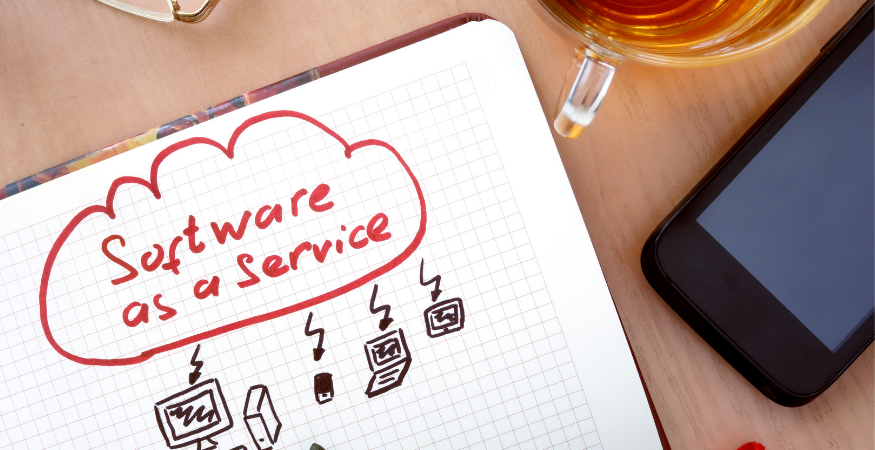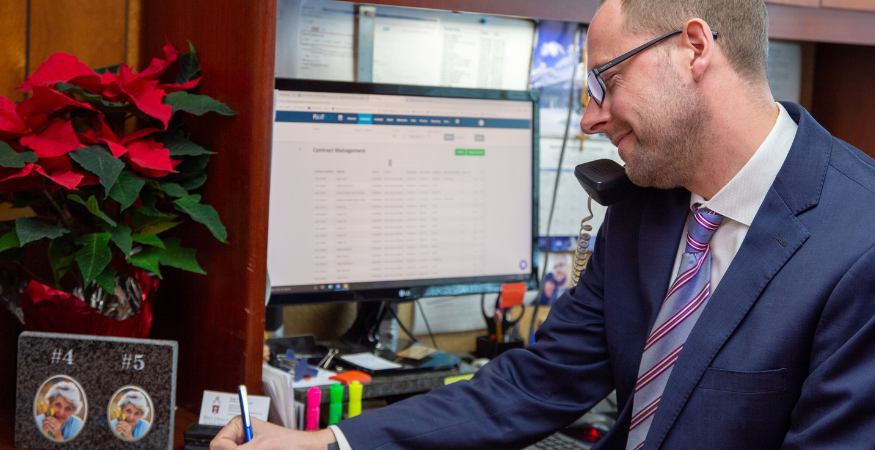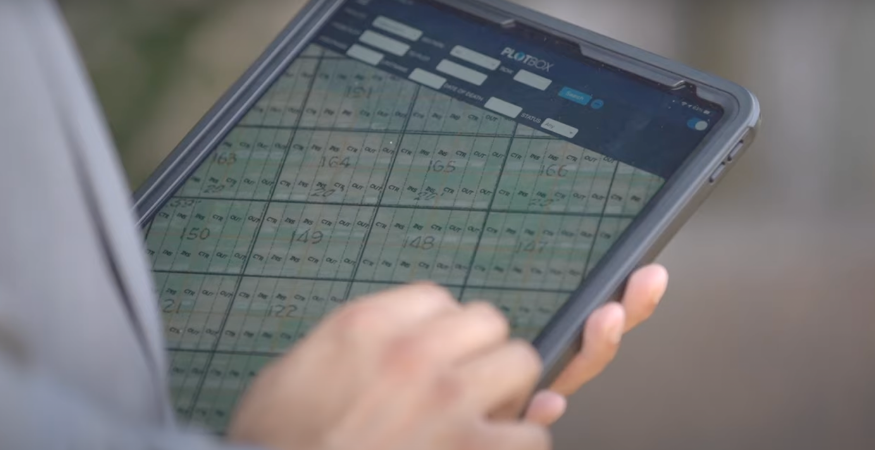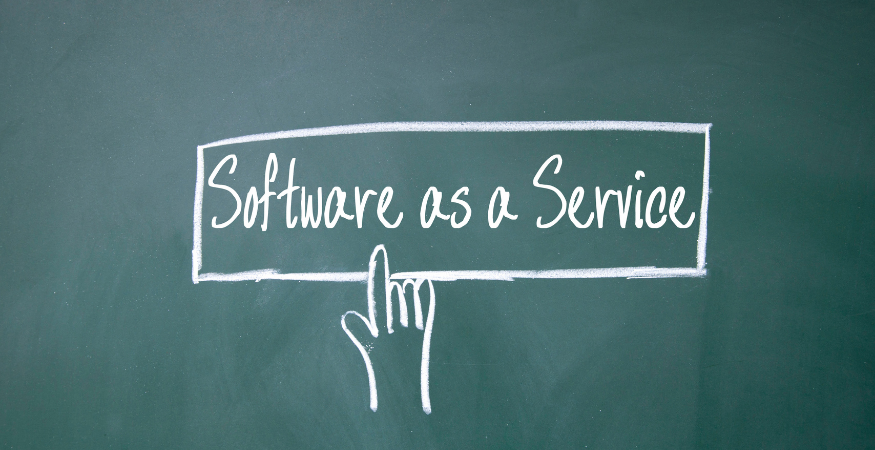Any conversation regarding digital transformation or legacy system modernisation (if that’s you - congratulations) will inevitably turn to SaaS and cloud technology.
Why? Because SaaS (Software as a Service) represents a shift in how organisations are deploying and interacting with IT systems and software.
With its rising popularity changing the way in which businesses operate and invest their IT resources, we take a quick look at what it is, and what the benefits are for cemeteries, crematories and funeral homes.
Below, you’ll also find a downloadable eBook to help you decide on the approach that’s right for you.

What is SaaS?
SaaS is a method of providing and acquiring software. Most often, SaaS-based systems are delivered 'in the cloud', or using remote computing resources managed by a third party.
Put simply, it’s a subscription-based model by which customers access applications over the internet, via web and mobile browsers, the infrastructure for which is maintained, managed and updated by the provider. [1]
Examples of SaaS include: Slack, Zoom, Gmail, Hubspot and PlotBox.
This is in contrast to the traditional model of purchasing software on a perpetual license - software that is installed on a specified number of computers for an unlimited period of time, with support purchased separately, either on a time-based contract, or on a ‘per-incident’ basis, as well as upgrades and enhancements.
Under this model, companies are responsible for maintaining their own infrastructure, as well as the 'people resources' required to maintain the equipment, security, workstations etc.
In comparing the two models, we begin to see some of the benefits of the SaaS in terms of cost, accessibility and resource management.
SaaS and cloud technology
SaaS and cloud technology are inextricably linked. SaaS is the most popular of the 3 main cloud computing service models, which also include IaaS (Infrastructure as a Service) and PaaS (Platform as a Service). [2]
IaaS provides access to servers, data storage and networking in the cloud, while PaaS provides access to platforms that allow organisations to develop and deploy their own applications.
While not mutually exclusive, many businesses will use a combination of these - and each have their merits, depending on need.
But let’s take a quick step back. What exactly is the cloud?

“The Cloud” is a catch-all term to describe many different methods of providing remote access to software and data via the internet, rather than on your local computer. [3] Broadly speaking, it refers to ‘where’ and ‘how’ data is stored and managed.
Not all ‘clouds’ are the same
From self-hosted or co-located private clouds to public clouds, the capabilities, risks and methods to deliver cloud-based services can vary greatly - determined in part by how and where the infrastructure is managed, and the data stored.
Read more about cloud types in our eBook.
What does this all mean for deathcare providers?
Businesses are increasingly relying on cloud services for everything they do: from document creation, file sharing, collaboration and communication. The customer experience is becoming a digital one, and as expectations change and digital adoption accelerates, you may be asking yourself if your current systems and processes allow you to meet these changing needs.
With all of that in mind, here are 5 benefits of using SaaS and cloud cemetery software to deathcare providers:

#1 Cost savings
Budget will always be a key factor when considering any sort of digital transformation, and can be determined, or limited by both the size and scale of your organisation and the scope of your ambition.
SaaS removes many of these limitations.
With SaaS, you can avoid incurring much of the up front investment that comes with costly on-site hardware installations, and the ongoing costs associated with outsourcing IT management, unpredictable equipment, and operating and maintenance expenses.
In effect, it provides you with predictable operating expenses and cost savings over time.
#2 Accessibility
With a cloud platform, all you effectively need is an internet connection for 24/7 access to your data. Being able to access information at any time, from anywhere provides you and your teams with unprecedented mobility.
We most recently saw the advantages of this in terms of business continuity, as deathcare providers (and businesses in general) were forced to adapt to the challenges of COVID-19, including imposed lockdowns, and the growing prevalence of remote working.
As a cloud-based service, we saw first hand how PlotBox customers were able to adapt quickly to this new normal.
Seamlessly transitioning to remote working when offices closed down, having constant access to their data meant that they could continue to serve families without interruption, as well as carry out their normal sales functions of selling pre-need, at-need, taking payments, and referencing cemetery maps - all from the safety of their own homes.
The accessibility afforded by cloud cemetery software also allows teams to collaborate and communicate more easily. Access to the same ‘single source of truth’, with real time information updates, can help to create innumerable process efficiencies and smarter workflows.

#3 Agility and Scalability
As cloud-based software is hosted on the vendor’s servers rather than installed locally, it’s much faster to deploy - allowing you to benefit from much shorter implementation times.
And as the software is managed and maintained by the vendor, this also means that live updates are provided to you automatically. These continuous updates, afforded to you as part of your contract, means that your software is being kept constantly up to date, without incurring big upgrade charges.
The collaborative nature of SaaS also means that you can provide feedback to your software partner - ensuring that your systems are doing exactly what you need them to do.
The scalability of the SaaS model also allows you to access new services and features, or add new users to accommodate changing needs - again, without incurring a large outlay. This flexibility allows you to scale up or down as required and only pay for capacity as and when it's needed.

#4 Legacy protection and future-proofing
Really, the two key factors for deathcare providers in considering a digital transformation project are how it can help them to protect their legacy and secure their future. The bottom line is that having your records stored securely, backed up and protected in the cloud reduces the risk of losing them.
Think of the history you possess and what it would mean to lose that.
Then consider if your current systems; whether that’s historical, paper records, or older, disjointed IT systems - put you at risk of that happening.
There are a number of risks associated with running outdated or unsupported software - including security vulnerabilities, the impact of system failures, and the (predictably) unpredictable costs associated with rectifying them.
Not only this, but running old systems will limit your future planning for growth. If you need to upgrade your hardware, you may simply not be able to run your old software on it. Running a retired database on a new computer with the latest version of its operating system won’t automatically work - costing you valuable time and money.
Moreso, as technology moves forward, it’s important that you have the agility a cloud platform provides to move forward with it.
Learn more about the dangers of using unsupported software.
#5 Security
“Will my data be secure?”. It’s a question we hear a lot from prospective customers - again due, in part, to some of the ambiguity around what actually constitutes ‘the cloud’.
In most cases, however, on-premise systems are actually riskier and more subject to failure.
Why? First, you need the ability to support and maintain the computer and network hardware necessary to run your systems, along with the ability to install, maintain and support the application, and the server, network and security software required to run it, as well as performing major upgrades every few years.
Public cloud services can offer the highest levels of security - PlotBox for example, partners with cloud computing service, Microsoft Azure (used by over 95% of the Fortune 500 companies), regularly backing up data which is stored securely across multiple data centres to protect against loss or corruption.
Read more on the benefits of cloud-computing here.
In summary, SaaS provides many benefits for deathcare providers, including: cost savings, scalability, accessibility and legacy protection. As with every major decision, however, it's important to have all of the information you need to make the right decision for you.
Refs
[1] What is SaaS?
Microsoft Azure
[2] "IaaS vs. PaaS vs. SaaS: Here's What You Need to Know About Each"
S. Bernazzani, HubSpot, Jul 22
[3] Too Embarassed to ask: What is the Cloud and how Does it Work?
B. Cha, Vox, Apr 2015
Like to learn more? Download our FREE eBook below:

